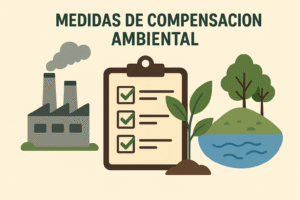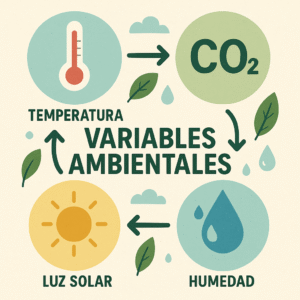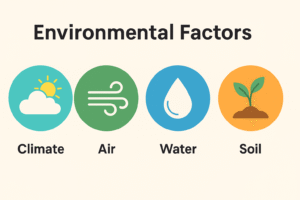Environmental variables are the factors or conditions of the environment that directly influence living organisms, ecosystems, and even industrial processes. Understanding how an environmental variable affects our daily lives is crucial to addressing challenges such as climate change, sustainability, and public health.
What Are Environmental Variables?
An environmental variable is any physical, chemical, biological, or social characteristic of the environment that affects organisms or processes within a system. These variables are widely studied in ecology, biology, environmental science, and engineering.
Difference Between Environmental Variable and Environmental Factor
Although often used interchangeably, there is a key distinction between both concepts:
- Environmental variable: Refers to a measurable and quantifiable parameter of the environment. Examples include temperature, relative humidity, carbon dioxide (CO₂) concentration in the air, or dissolved oxygen levels in water. These can be expressed in numbers and units, allowing for objective comparisons.
- Environmental factor: Refers to a broader influence on organisms or processes, which can be quantitative or qualitative. For instance, urban noise or deforestation are factors, even if they cannot always be measured precisely.
👉 In other words:
- Every environmental variable can be part of an environmental factor, but not every factor is a measurable variable.
- In scientific research, environmental variables are preferred because they allow precise, replicable measurements.
- In environmental management or policymaking, environmental factors are more relevant since they combine measurable variables with social, economic, or cultural conditions.
Practical example:
- A researcher may measure water temperature (environmental variable) to analyze its effect on freshwater fish.
- However, when discussing water pollution as a whole (environmental factor), multiple variables come into play: temperature, presence of heavy metals, dissolved oxygen, and even industrial discharges.
Types of Environmental Variables
Physical (temperature, humidity, light)
Solar radiation, humidity, and temperature regulate processes such as photosynthesis and the water cycle.
Chemical (oxygen, CO₂, pH)
These control air and water quality. For example, dissolved oxygen in rivers determines the survival of fish and microorganisms.
Biological (flora, fauna, microorganisms)
Include species that make up an ecosystem, influencing biodiversity and ecological balance.
Social and Economic (urbanization, consumption, industry)
Human activities that alter the environment, such as industrial emissions, transportation, and consumption habits.
Examples of Environmental Variables in Different Contexts
- In Biology and Ecology
Studying environmental variables helps us understand how species are distributed in ecosystems.
Example: the relationship between altitude and vegetation types. - In Sustainability and Environmental Management
Organizations use these variables to measure the environmental impact of their activities, design energy-saving strategies, and reduce emissions. - In Engineering and Scientific Experiments
Experiments often control variables such as temperature or pressure to achieve reliable and replicable results.
Importance of Environmental Variables
- Impact on Human Health and Well being: Air quality, access to clean water, and noise pollution are direct examples of how an environmental variable affects human health.
- Role in Climate Change and Biodiversity: Increasing CO₂ levels and deforestation are key variables driving global warming and species loss.
- Practical Applications in Smart Cities and Businesses: Sensors measuring humidity, temperature, or air quality provide real time data to support decision making in sustainable urban development.
How to Measure and Monitor Environmental Variables
Sensors and Monitoring Technology
Specialized devices record temperature, humidity, particulate matter, and more. These datasets are essential for smart cities projects.
Traditional Measurement Methods
Thermometers, rain gauges, or pH meters have been historically used in science and agriculture.
Challenges in Data Collection
Resource limitations, geographical barriers, and unequal access to technology are major obstacles, especially in developing regions.
Frequently Asked Questions About Environmental Variables
What are environmental variables?
They are physical, chemical, biological, or social characteristics of the environment that affect organisms and natural processes.
What are examples of environmental variables?
Temperature, humidity, dissolved oxygen, air pollution, animal species, and urbanization.
How do environmental variables influence humans?
They directly affect health, access to natural resources, and quality of life in urban areas.
What is the relationship between environmental variables and sustainability?
They are key indicators to evaluate and improve sustainable development policies.
Conclusion
Environmental variables are essential to understanding how our planet functions and how human activities shape it. Integrating their analysis into education, research, and industry is fundamental for building a more sustainable future.







